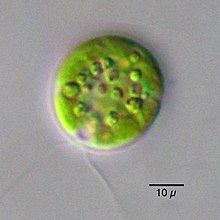Chlamydomonas
| Chlamydomonas | ||||||||||||
|---|---|---|---|---|---|---|---|---|---|---|---|---|

Chlamydomonas sp. With this SEM image only the surface of the object is shown. |
||||||||||||
| Systematics | ||||||||||||
|
||||||||||||
| Scientific name | ||||||||||||
| Chlamydomonas | ||||||||||||
| Honorary |

1. Flagellum , 2. Mitochondrion , 3. Contractile vacuole , 4. Eye spot , 5. Cup- shaped chloroplast , 6. Golgi apparatus , 7. Starch granules, 8. Pyrenoid , 9. Vacuole , 10. Cell nucleus , 11 . endoplasmic reticulum , 12, cell membrane 13 cell wall
Chlamydomonas is a genus of unicellular green algae that is mainly found in freshwater, but also in marine. Two similar ( isocontal ) flagella are characteristic . Currently (May 2018) the genus includes almost 600 known species. In research, Chlamydomonas reinhardtii is important as a well-studied model organism .
description
The cells are mostly spherical or almost spherical, in some species spindle-shaped . At the front end there are two isocontal flagella, which in some species are only formed in the course of reproduction. Each cell contains only one chloroplast , the shape of which is very different depending on the species. There are two contractile vacuoles in the anterior end . An eye spot in the front part of the chloroplast is also characteristic . The cell wall consists of seven layers and contains mainly glycoproteins , while cellulose is absent.
Occurrence
Typical habitats include small bodies of water that dry out at times and nutrient-rich lakes, as well as the moist soil. In C. reinhardtii has been demonstrated that they present in the environment cellulose can utilize. Some species such as C. nivalis live in meltwater and in snow fields in the high mountains, where they store carotenoids as protection from the strong ultraviolet radiation and thus cause the phenomenon of blood snow .
Reproduction
The vegetative reproduction does not take place by simple division, but with the formation of flagellated zoospores , as a cell divides lengthways several times within the cell wall and then the daughter cells are released. The latter happens through the release of enzymes that dissolve the cell wall. Likewise, during sexual reproduction the gametes can develop in groups within one cell, which then becomes a gametangium , or a single-celled alga becomes a gamete as a whole. In both cases isogamy, anisogamy as well as oogamy occur; H. the gametes of both sexes can be the same outwardly, or the female gamete is considerably larger than the male, or it is a non-flagellated and therefore immobile egg cell . Isogamy is the most common. Sexual reproduction is triggered by unfavorable living conditions such as a lack of nitrogen, and the zygote created by the union of the gametes is a permanent stage, protected by a tough wall. When it germinates, the reduction division ( meiosis ) takes place immediately ; they are thus haplons in which all cells except the zygote are haploid .
Web links
- YouTube: Short clip of a Chlamydomonas cell under the light microscope . The orange eye spot is clearly visible. Retrieved April 6, 2011.
Individual evidence
- ↑ AlgaeBase Taxonomy Browser: Genus: Chlamydomonas , accessed on May 7, 2018.
- ↑ a b c AlgaeBase: Chlamydomonas. accessed on June 28, 2018.
- ↑ Olga Blifernez-Klassen, Viktor Klassen u. a .: Cellulose degradation and assimilation by the unicellular phototrophic eukaryote Chlamydomonas reinhardtii. In: Nature Communications. 3, 2012, article 1214, doi: 10.1038 / ncomms2210
- ^ HL Gorton, TC Vogelmann: Ultraviolet Radiation and the Snow Alga Chlamydomonas nivalis (Bauer) Wille. In: Photochemistry and Photobiology : Vol. 77, No. 6, 2003, pp. 608-615.
- ^ Rainer Bergfeld: Sexuality in plants . Ulmer, Stuttgart 1977, ISBN 3-8001-3419-5 , p. 27.
